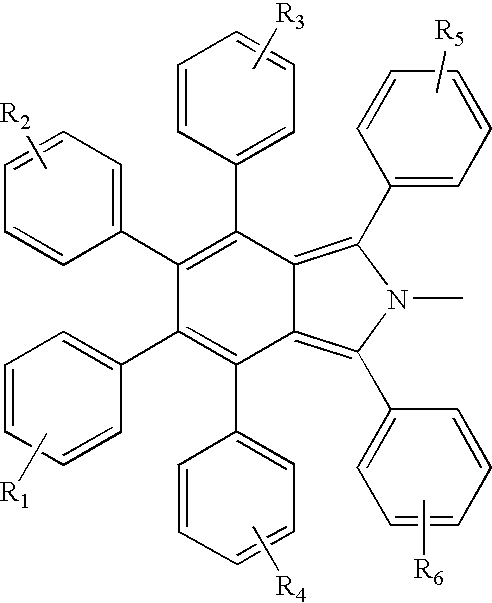Electroluminescent devices
a technology of electroluminescent devices and electrodes, which is applied in the direction of discharge tube luminescnet screens, natural mineral layered products, etc., can solve the problems of preventing the efficient injection of carriers into the light-emitting layer, material has never been used in small molecule organic el devices, and the impurity likely to form traps should not be produced
- Summary
- Abstract
- Description
- Claims
- Application Information
AI Technical Summary
Problems solved by technology
Method used
Image
Examples
example 1
[0083] Synthesis of 1,2-bis(benzoyl)-1,2-dibromoethylene{1,2-bis(benzolyl--1,2-dibromoethane}
[0084] 1,2-bisbenzoyl-ethylene (C.sub.16H.sub.12O.sub.2: 236.27, 5.5 g, 23.3 mmol) was dissolved in 40 ml CHCl.sub.3, to which was added a solution of bromine (FW: 159.81, d=3.1023, 1.2 ml, 23.3 mmol) in CHCl.sub.3 (8 ml). The reaction mixture was stirred under an atmosphere of nitrogen for 30 min and concentrated under reduced pressure to give a white solid. After recrystallization from ether / EtAc, the yield was 7.2 g (78.4%).
example 2
[0085] Synthesis of 1,2-bis(benzolyl)acetylene
[0086] To a solution of 1,2-bisbenzoyl-1,2-dibromoethylene (C.sub.16H.sub.12O.sub.2Br.sub.2: 396.08, 6 g, 15.15 mmol) in reagent-grade acetone (150 ml) under an atmosphere of nitrogen was added triethylamine (C.sub.6H.sub.15N, 101.19, d=0.72, 4.4 ml, 30.30 mmol). After stirring the reaction mixture for 10 min at reflux temperature, the quaternary salt was filtered and the filtrate concentrated under reduced pressure. After recrystallization from ethanol, the yield was 3.02 g (yellow color, 85%).
example 3
[0087] Synthesis of 1,2-bis(benzoyl)-3,4,5,6-tetraphenylbenzene
[0088] 1,2-bis(benzoyl)acetylene (C.sub.16H.sub.10O.sub.2, 234.27, 2 g, 8.54 mmol), tetraphenylcyclopenta-dienone (C.sub.29H.sub.20O, 384.47, 3.28 g, 8.54 mmol), and 40 g benzophenone were refluxed for 2 hr under an atmosphere of nitrogen. The reaction mixture was cooled to 30.degree. C. and poured into a large volume (250 ml) of methanol. The tan precipitation was washed with methanol (2.times.10 ml) and refluxed in toluene (25 ml) charcoal (a spoon) to give a white crystal in 43% yield.
PUM
| Property | Measurement | Unit |
|---|---|---|
| Fraction | aaaaa | aaaaa |
| Fraction | aaaaa | aaaaa |
| Length | aaaaa | aaaaa |
Abstract
Description
Claims
Application Information
 Login to View More
Login to View More - R&D
- Intellectual Property
- Life Sciences
- Materials
- Tech Scout
- Unparalleled Data Quality
- Higher Quality Content
- 60% Fewer Hallucinations
Browse by: Latest US Patents, China's latest patents, Technical Efficacy Thesaurus, Application Domain, Technology Topic, Popular Technical Reports.
© 2025 PatSnap. All rights reserved.Legal|Privacy policy|Modern Slavery Act Transparency Statement|Sitemap|About US| Contact US: help@patsnap.com



